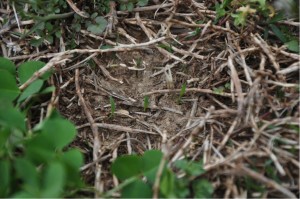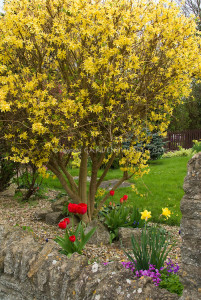Given the warm temperatures in North Texas, Dr. Matt Elmore, sent out a note today alerting us that NOW is the time to treat for crabgrass! I thought this was good information for all our readers, even for those of you who are not in north TX. I have heard about forsythia bush being a guide to planting but never, thought of it as a guide for herbicide applications, great tip from Matt!
With soil temperatures rising to the upper 50s and low 60s this week and we may see crabgrass germination very soon, especially if we get rain this weekend. Now is a great time to apply pre-emergent herbicides. Chad Gulley, Smith County Extension Agent – Agriculture and Natural Resource sent Dr. Elmore a photo of a forsythia plant starting to bloom. Matt recommends homeowners and other turf personnel apply pre-emergent herbicides soon. See the aggieturf link and this image (upper left) to see what germinating crabgrass looks like. When looking for seedlings, scout (walk) south-facing slopes, bare areas, and areas along sidewalks for crabgrass. I personally will say, check your bare spots and weak areas in your lawn that is typically where I start to see the growth.
General Information
Crabgrass germination typically occurs in late winter (February to mid-March), but varies from year to year, based on temperature, rainfall, and location. Crabgrass germination usually begins when the soil temperature at a 2-inch depth reaches 55°F for at least 3 days. Since crabgrass is the first summer annual grassy weed to germinate we apply pre-emergence herbicides based on its germination.
The forsythia (Forsythia spp.) plant can be used to time preemergence herbicide application. Make pre-emergence applications when forsythia is in full bloom (their yellow flowers are usually among the first plants to bloom). Forsythia plants are more prevalent in East Texas—they are rare in West Texas.
Sometimes referred to as “pre” herbicides, preemergence herbicides must be applied before the target weed geminates or emerges, or they will not control it. Although these herbicides are commonly used to control annual weeds that germinate at predictable times of year, and will not control perennial weeds. A couple tips for pre-emergence herbicides.
Selecting a Product
A pre-emergence herbicide is the most effective way to control crabgrass. They are especially recommended for lawns with a history of crabgrass problems.
Common active ingredients found on products available to homeowners include pendimethalin, dithiopyr, and prodiamine. Trade names for these products include but are not limited to: Pre-M, Bonide Crabgrass Preventer and Halts Crabgrass Preventer. Pre-emergence herbicides that contain these active ingredients will usually provide suitable crabgrass control when applied before crabgrass germination and according to the product label. These products mostly control grassy weeds, although they may control some broadleaf weeds. Always check to ensure that the product can be safely used on the turfgrass species in your lawn. To see what is recommended for athletic fields and commercial uses check out this Pre_emergement_handout (PDF File). It highlights preemergence herbicides labeled for control of grassy (crabgrass, goosegrass, annual bluegrass, etc.) and small-seeded broadleaf weeds (such as purslane, spurge, chickweed).
Many pre-emergence products that contain dithiopyr are labeled for early post-emergence control of small (seedling) crabgrass plants. This includes products such as Bonide Crabgrass and Weed Preventer.
Consider using these products if you cannot make the application before germination and check the label to ensure it contains dithiopyr and is labeled for early post-emergence control.
Corn gluten meal is an organic option for crabgrass control. Research has demonstrated that crabgrass control with this product is inconsistent but it may be effective in some situations.
It is best to select a pre-emergence product that does not contain nitrogen fertilizer. Companies that distribute products nationally as crabgrass preventers have products that come with nitrogen. While these products may be suitable for northern regions of the U.S. they should not be used in Texas. Warm-season grasses are still mostly dormant when crabgrass germinate and nitrogen fertilizer should not be applied until the lawn is mostly green.
Unlike “Weed and Feed” products that will control broadleaf weeds and should not be applied around tree drip lines, pre-emergence herbicides are usually safe for use around trees and ornamentals. Products that contain atrazine are one exception. Some are labeled for use over the top of ornamentals.
 Always read the product label thoroughly for use restrictions.
Always read the product label thoroughly for use restrictions.
Pre-emergence herbicides are effective only if they are applied uniformly and are watered into the soil by rainfall or irrigation before the crabgrass or other target weed emerges. See the product label for information on the amount of irrigation or rainwater needed.
Recent or upcoming renovations and severely damaged lawns.
After they are watered in, the herbicide molecules remain in the upper layer of soil and control and weeds or desirable grasses that germinate from seed for several weeks. If you plan to seed or sod, do not apply a pre-emergence herbicide without first checking the label for the appropriate reseeding/sodding interval.
Also, do not apply some pre-emergence herbicides before sprigging or sodding. If you are planning this type of turf renovation, use other weed-control options. In general, apply these herbicides only to well-established turfgrass. See the product label if you have established turf from sod, seed, or sprigs within the previous year. Many pre-emergence herbicides will impede encroachment of existing turfgrass into areas damaged by winterkill, traffic, or diseases. Do not use pre-emergence herbicides if your lawn has been severely damaged.
Finally, here is a video that explains some of what is discussed above.
Need specific help, feel free to contact our turfgrass specialists you can find them at the Aggie Turf page https://aggieturf.tamu.edu/turfgrass-faculty/
A special thank you to Dr. Matt Elmore, Assistant Professor and Extension Turfgrass Specialist, AgriLife Extension for this information.



 .
.